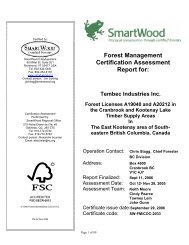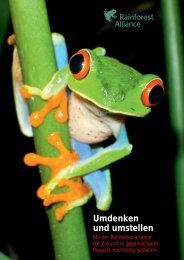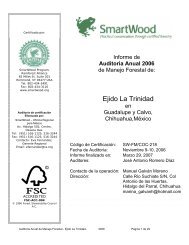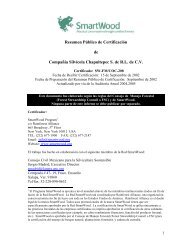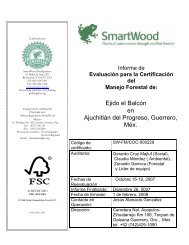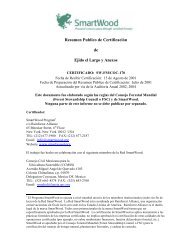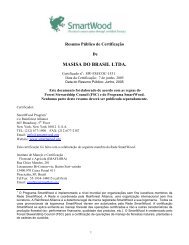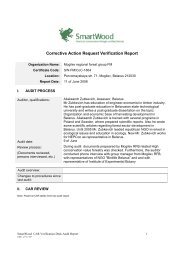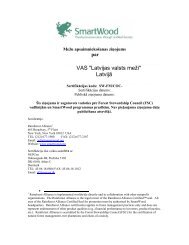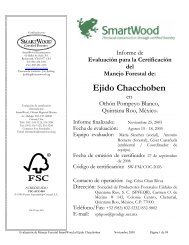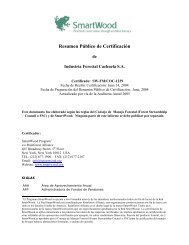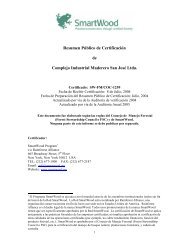[C] The Hidden Frontier of Forest Degradation - Rainforest Alliance
[C] The Hidden Frontier of Forest Degradation - Rainforest Alliance
[C] The Hidden Frontier of Forest Degradation - Rainforest Alliance
Create successful ePaper yourself
Turn your PDF publications into a flip-book with our unique Google optimized e-Paper software.
We review here case studies to provide location-specific<br />
and strategy-specific examples <strong>of</strong> the major<br />
themes <strong>of</strong> the paper. Since strategies to both avoid<br />
logging and reduce logging impacts are receiving a great deal<br />
<strong>of</strong> interest, we include two case studies on logging: a “stop logging”<br />
strategy being implemented in Bolivia and an “improved<br />
forest management” (IFM) strategy being implemented in<br />
California. We include a third case study on indigenous community-based<br />
fire management as a strategy to reduce carbon<br />
emissions in Australia. Finally, we describe an improved<br />
efficiency cook stove program in Cambodia that reduces fuelwood<br />
collection. In each case, we describe the major themes <strong>of</strong><br />
this paper: (1) drivers and magnitude <strong>of</strong> degradation emissions,<br />
(2) accounting methods, (3) strategic approach, and (4) political<br />
& institutional challenges, standards and solutions. Since<br />
these case studies are projects (not national-scale), the last<br />
issue revolves largely around standards at the project scale.<br />
Halting Emissions from Logging at Noel Kempff, Bolivia<br />
SUMMARY FOR POLICY & PRACTICE<br />
» Emissions avoided by stopping commercial logging generated the majority <strong>of</strong> REDD credits from the Noel Kempff Mercado Climate Action<br />
Project, the first third party verified REDD project.<br />
» Leakage from avoided commercial logging was successfully tracked at a local scale (activity leakage) and modeled at a national scale (market<br />
leakage), resulting in a 16 percent deduction to credits avoiding degradation generated to cancel out the effects <strong>of</strong> leakage.<br />
» A well-designed community development plan was crucial to REDD to: a) assure local communities and indigenous groups benefit from project<br />
activities and b) address the drivers <strong>of</strong> deforestation and degradation.<br />
» Robust standards recently developed for REDD, particularly the Voluntary Carbon Standard, incorporate lessons learned from the pioneering<br />
efforts <strong>of</strong> Noel Kempff. <strong>The</strong>se new standards, which didn’t exist when Noel Kempff was started, allow project developers to design REDD activities in<br />
ways that generate high quality verified emissions reductions by accounting for the challenges posed by measuring/monitoring, baselines, leakage<br />
and permanence.<br />
PROJECT SUMMARY<br />
<strong>The</strong> Noel Kempff Mercado Climate Action Project (“Noel<br />
Kempff”) was one <strong>of</strong> the world’s first large-scale projects to<br />
implement Reducing Emissions from Deforestation and<br />
<strong>Degradation</strong> (REDD) in practice. Noel Kempff is addressing<br />
the drivers <strong>of</strong> both D’s in REDD: deforestation from conversion<br />
to agriculture and degradation from logging activities in<br />
timber concessions. In late 1996, <strong>The</strong> Nature Conservancy and<br />
Bolivian conservation organization Fundación Amigos de la<br />
Naturaleza (FAN) worked together with the Government <strong>of</strong><br />
Bolivia and timber concession holders to terminate logging<br />
rights in an area in the northeast <strong>of</strong> the Department <strong>of</strong> Santa<br />
Cruz and incorporate the land into an existing national park.<br />
In addition, to address the threat <strong>of</strong> deforestation from agricultural<br />
expansion, project developers worked with local<br />
communities on a robust community development plan, which<br />
included the facilitation <strong>of</strong> their application for land tenure<br />
and alternative employment opportunities. In 2005, Noel<br />
Kempff became the first REDD project to be verified by a<br />
third party, using rigorous standards based upon those developed<br />
for the Kyoto Protocol’s Clean Development Mechanism.<br />
With achievement <strong>of</strong> this milestone, the project serves as a<br />
powerful example <strong>of</strong> how well-designed REDD projects can<br />
result in real, scientifically measurable, and verifiable emissions<br />
reductions.<br />
DRIVERS AND MAGNITUDE OF DEGRADATION EMISSIONS<br />
<strong>The</strong> main driver <strong>of</strong> deforestation in the area was expansion <strong>of</strong><br />
subsistence farming activities by seven local communities situated<br />
adjacent to the project boundaries. <strong>The</strong>se communities<br />
also depended on the forest for hunting, fishing, fuelwood and<br />
botanicals. <strong>The</strong> main driver <strong>of</strong> degradation in the area was<br />
commercial logging operations in four timber concessions<br />
adjacent to (and in one case overlapping) the original national<br />
park boundaries. A sawmill on one <strong>of</strong> the concessions provided<br />
employment for about 20 local community members.<br />
<strong>The</strong> project is estimated to avoid the emission <strong>of</strong> 5,838,813<br />
metric tons <strong>of</strong> carbon dioxide equivalent (tCO 2 e) over its 30-<br />
year lifetime. Of this total, about three-quarters <strong>of</strong> the carbon<br />
benefits, or close to 4,500,000 tCO 2e , are estimated to come<br />
from the avoided degradation component <strong>of</strong> the project. Thus<br />
far, a total <strong>of</strong> 1,034,107 tCO 2 e have been verified to have been<br />
avoided from 1997 to 2005 (371,650 tCO 2 e from avoided<br />
deforestation and 791,433 tCO 2 e from avoided degradation).<br />
This equates to 763 hectares (ha) saved from deforestation<br />
and 468,474 square meters <strong>of</strong> timber left standing.<br />
STRATEGIC APPROACH<br />
In order to avoid future deforestation from agricultural<br />
expansion, project developers worked with the seven local<br />
communities on a 10-year community development plan. <strong>The</strong><br />
plan included five main strategies to ensure that negative impacts<br />
T H E H I D D E N F R O N T I E R O F F O R E S T D E G R A D A T I O N $ 35


![[C] The Hidden Frontier of Forest Degradation - Rainforest Alliance](https://img.yumpu.com/30611265/39/500x640/c-the-hidden-frontier-of-forest-degradation-rainforest-alliance.jpg)
